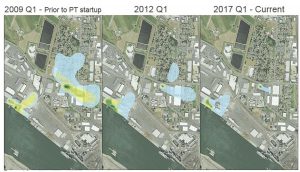Port of Vancouver USA making progress in groundwater cleanup
The Port of Vancouver USA is making significant progress in the cleanup of pollution released decades ago by a company that once occupied what is now port property. The company’s operations, and subsequent contamination, was originally located at the corner of Mill Plain and Fourth Plain boulevards before moving across the street to the current Cadet property.
Although contamination occurred years before the port owned the properties, cleanup and the implementation of programs to minimize the need for future cleanup efforts are top priorities for the port. Over the years, the port has successfully reduced groundwater contamination on its property and in neighboring private properties by excavating contaminated soil, injecting hydrogen peroxide into the groundwater, installing treatment systems in the Fruit Valley neighborhood and constructing a pump and treat system.
Cleanup efforts are closely monitored by a port contractor and the Washington State Department of Ecology, and tests they’ve performed are showing positive results. Since its installation, the port’s pump and treat system has treated more than 10 billion gallons of contaminated groundwater. Shallow groundwater contamination has been reduced by 96 percent and is now limited to a small portion of port-owned property. Contamination of deeper areas of the aquifer, or intermediate groundwater, has been reduced by 89 percent. The results have been so successful that the port was able to remove treatment systems in the Fruit Valley neighborhood ahead of schedule.
There is still some work to be done. The port will continue to monitor the cleanup and work with Ecology to ensure our groundwater and nearby aquifers are protected now and in the future. Test results, plans of action and a history of the cleanup site can be found on Ecology’s website.
In addition to the groundwater cleanup, the port has, in partnership with Ecology, returned more than 270 acres of contaminated land to productive use. These properties were underutilized and today are productive industrial sites providing jobs and economic benefit to our community.

